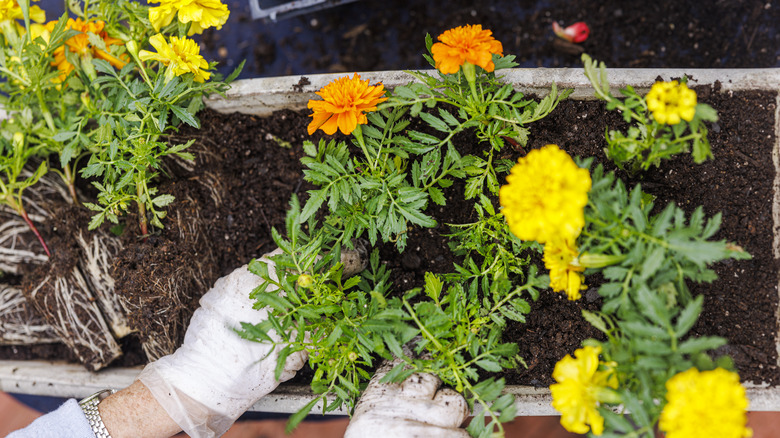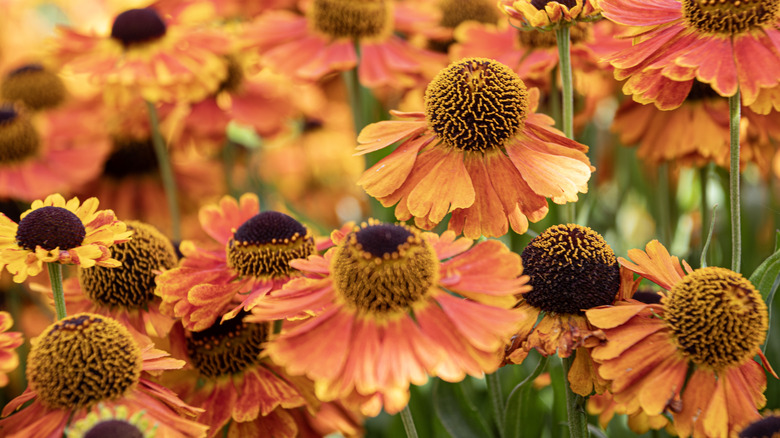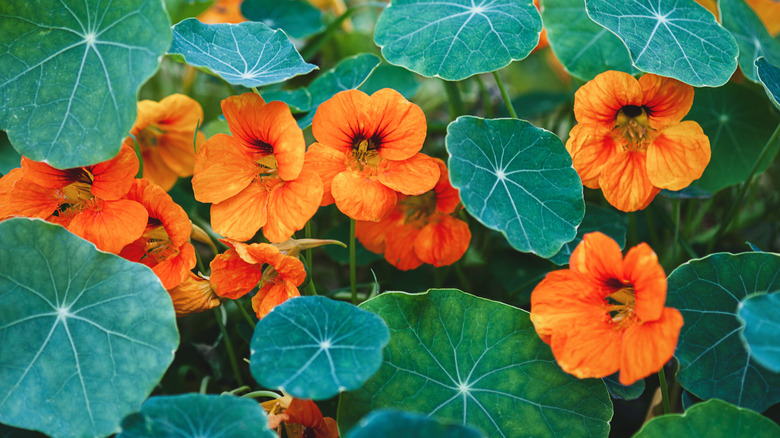Your Chrysanthemums Will Thrive Alongside These 12 Companions In The Garden
Chrysanthemums, also referred to as simply mums, are a herbaceous flower and member of the Asteraceae family. Many gardeners love to use these bright flowers in their gardens. Chrysanthemums are late bloomers, often blossoming in the late summer and as late as the fall. They stun with their clustered vibrantly colored petals, showing shades of pink, red, yellow, orange, or purple. They thrive in USDA hardiness zones 5 through 9, and prefer rich, acidic, and moist soil, as well as full sun exposure. Most mum varieties are perennials, meaning that they will regrow year after year without needing to be replanted, which is incredibly convenient for lovers of mums. There are annual cultivars, however, which will die out when temperatures turn cold.
People often add companion plants alongside their chrysanthemums. These plants can symbiotically benefit one another in a myriad of ways, from pest control to soil enrichment. Though more scientific studies and research are needed, many expert gardeners have attested to the benefits of companion planting in their own gardens. For instance, chrysanthemums are known to ward off garden pests such as fleas and mosquitos, which makes them ideal next to pest-prone species. But which plants help chrysanthemums out? We found 12 of the best plants to grow around your mums to provide additional growth, soil benefits, pest and disease resistance, or add stunning color to your late-summer garden.
1. Chives
While chrysanthemums do a great job of warding off all sorts of pests, they are vulnerable to aphids. Aphids drink the sap from the plant and can disfigure, stunt, and kill it. An easy solution is to grow chives (Allium schoenoprasum) near them. Chives, like chrysanthemums, are herbaceous perennials, grow well in USDA zones 3 through 9, and enjoy full sun to light shade. Their grassy stalks produce pale pink to purple blossoms and smell vaguely of onion and garlic, which deters aphids. Plant chives near your mums so they can also benefit from these aphid-repelling qualities.
2. Autumn sage
The mums you find in a grocery store and put in a pot for an autumnal display are often over-bred annuals that may not do much for pollinators. But autumn sage (Salvia greggii) is an excellent late-season flowering pollen and nectar source that attracts honey bees, as well as butterflies, and grows well with mums. By planting them alongside each other, you can be sure your fall display does more than just look pretty, as it will benefit so many pollinators. Autumn sage grows best in USDA zones 6 through 9 in full sun and well-drained soil.
3. Asters
Asters (Symphyotrichum spp.), like chrysanthemums, are part of the Asteraceae family. These herbaceous perennials are late-blooming, sun-loving flowers that do best in well-draining soil and grow in USDA zones 3 through 8. Because these share similar growing conditions with mums, they thrive together, especially as both have excellent insect-repelling properties, which can help protect other plants in your garden from pests. Asters are also a great source of pollen and nectar in the autumn and early winter. From an aesthetic perspective, asters provide stunning contrast against garden mums.
4. Marigolds
Marigolds (Tagetes spp.) are often planted as border plants as they can repel insects, like mums, as well as deer and rabbits. But marigolds offer a key benefit for mums — one of chrysanthemums' few enemies is known as the chrysanthemum leafminer, which eats away at its leaves, degrading the health of the plant. Luckily, marigolds naturally attract these pests' enemy: parasitic wasps. Marigolds grow in USDA zones 2 through 11, full sun, and moist, well-draining soil.
5. Sedum
If you get tired of your garden turning from a cornucopia of colors to a desolate wasteland in the fall, consider adding sedum alongside your mums. Also known as stone crop, sedum looks gorgeous from summer to the end of fall, and shares similar growing conditions to chrysanthemums, requiring full to partial sunlight and do best in USDA hardiness zones 3 through 10. The blossoms of the sedums are a favorite of pollinators such as bees and butterflies, while the lush succulent leaves offer a safe haven for beneficial insects and arachnids like ladybugs and spiders.
6. Helenium
Helenium (Helenium autumnale), also known as sneezeweed, is a beautiful mums companion and will help you make the most out of your autumnal garden, with gradients of orange, yellow, and red. Allergy sufferers, don't worry about it being called sneezeweed. It earned the nickname due to its use in a specific type of snuff powder. Your chrysanthemums will enjoy being planted by heleniums because they are very resistant to most pests. They thrive in USDA zones 4 through 8, moist, acidic to neutral soil, full sun, and bloom in the late summer and fall.
7. Coneflowers
Another late-season bloomer that will stun next to your chrysanthemums is coneflower (Echinacea). This flower blooms from midsummer well into fall in USDA zones 3 through 8 and requires full to partial sun and well-draining neutral to acidic soil. They also attract bees, butterflies, and even some songbirds as a late-season pollen source, making them a delightful addition to the garden. Coneflowers have a deep-reaching taproot system, which helps to aerate the soil, helping to maintain well-draining soil all on its own — a huge benefit for your sake and your chrysanthemums!
8. Yarrow
A pest that plagues beautiful chrysanthemums is two-spotted spider mites, which suck the nutrients from their leaves. Few pesticides are effective against this type of spider mite, but according to the University of Minnesota, some species of ladybugs feed on these chrysanthemum tormentors. Plant yarrow (Achillea millefolium) next to chrysanthemum, as it is a natural magnet for ladybugs, and these helpful insects may remove the threat of these mites. Yarrow blooms through summer and fall, making it a helpful protector during mum season. It thrives in USDA zones 3 through 9 with well-drained soil and full sun.
9. Dill
Dill (Anethum graveolens) also attracts ladybugs, which can ward off other unwanted pests, so dill may be able to offer chrysanthemums some protection as it also blooms in the late summer and early fall. Chrysanthemums mutually benefit dill by warding off insects as they have the chemical pyrethrum. Dill (often called dill weed) prefers well-drained soil and full sun. Even if they didn't symbiotically benefit each other, the fresh, herbaceous taste of dill and the bright gem tones of the chrysanthemums makes for a happy combination in any autumnal garden.
10. Bluebeards
Bluebeards (Caryopteris x clandonesis) look much like earlier-blooming lavender sprigs, but share similar growing conditions to mums, and will bloom at the same time as them in late summer to early fall. They're also great for pollinators and have a fragrance that repels local wildlife such as deer and rabbits. You can grow bluebeards in well-draining soil with full sun exposure. Bluebeards also share the same USDA hardiness zones 5 through 9 with chrysanthemums, and the pale purple colors would look lovely alongside pink, purple, and white mums.
11. Ornamental grasses
Chrysanthemums do beautifully next to colorful ornamental grasses, which are showy, feathery grass plants often featured in prairie gardening and xeriscaping. They look beautiful throughout much of the year, and provide a gorgeous backdrop for your chrysanthemums with warm hues and sprawling stalks. There are many varieties of ornamental grasses, but be sure to look for cold-hardy and drought-resistant grasses that will last through fall along with your mums, such as Miscanthus sinensis or Panicum varieties.
12. Nasturtiums
You'll find plenty of articles touting the benefits of planting nasturtiums alongside marigolds, but don't sleep on nasturtiums and mums in your late-summer and autumn garden. Nasturtiums are wonderfully pest-resistant and pollinator-friendly, and bloom through summer and fall. They have a smaller USDA hardiness range than chrysanthemums, only thriving in zones 9 through 11, but otherwise do nicely in similar conditions, requiring full sun and neutral, well-draining soil. Another fun benefit of nasturtium flowers is that they are edible, and can be added as a garnish or tossed in a salad for dinner.












